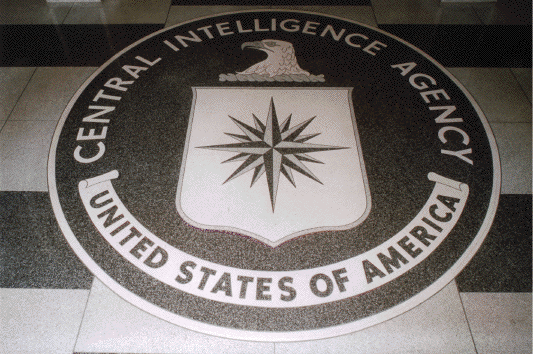CIA Lawyer Involved in Interrogation Policy Defends Character
A CIA lawyer who helped spread enhanced interrogation techniques to Guantanamo and Iraq defends his name, but concedes involvement.
Jul 31, 2020212.9K Shares3.4M Views
The Central Intelligence Agency floor (Wikimedia)
A CIA lawyer implicated in a Senate report as a key figure in the spread of abusive interrogation techniques angrily defended his reputation in a letter to senators — but declined to dispute the key points raised in the report.
Jonathan Fredman, formerly the chief counsel for the CIA’s Counterterrorism Center, wrote to the Senate Armed Services Committee on November 17, 2008 to dispute the characterization of him in documents the committee had released that spring. Those documents — the minutes of an October 2, 2002 meeting Fredman attended as a CIA representative at Guantanamo Bay — helped shape the narrative of the committee’s December 2008 report into the Bush-era Pentagon’s interrogation and detention regimes. That report, declassified on April 21, portrays Fredman as musing to his Guantanamo counterparts about, among other things, how threatening to kill detainees “should be handled on a case by case basis.”
Illustration by: Matt Mahurin
Fredman denied that characterization in his letter to the committee. “I did not say the obscene things that were falsely attributed to me at the Senate hearing,” Fredman wrote. “The so-called minutes misstate the substance, content and meaning of my remarks; I am pleased to address the actions that I did undertake, and the statements that I did make.” The full letterwas released to TWI after it filed a Freedom of Information Act request for it on April 22 with the Office of the Director of National Intelligence, where Fredman still works.
The Senate committee staff would not comment for this article. But Senate sources said that the account of the Guantanamo Bay meeting given in the minuteswas corroborated by numerous attendees of the meeting and others familiar with it. For the committee, the salient fact about the letter — which it received the day senators were scheduled to vote on the completed narrative of the report — was that it confirmed Fredman’s travel to Guantanamo to discuss CIA interrogation techniques and their legality with military personnel, which contributed to the Defense Department’s adoption of similar policies. Fredman’s letter appeared to be an attempt to clear his name, rather than a substantive refutation of his role in the spread of the torture techniques.
Before the October 2, 2002 meeting at Guantanamo Bay, the Defense Department was unaware that the CIA had legal authorization for a different interrogation regimen than the one coalescing at the Guantanamo detention facility. According to the minutes of the meeting, Fredman discussed those interrogation techniques and their legal rationales in detail. Discussing waterboarding, the minutes recount Fredman as saying “If a well-trained individual is used to perform this technique it can feel like you’re drowning. The lymphatic system will react as if you’re suffocating, but your body will not cease to function.” Fredman described other techniques, including pointing out that “it is very effective to identify phobias and use them (i.e., insects, snakes, claustrophobia).” After the meeting, Guantanamo lawyers recommended applying a similar system of interrogation techniques to detainees in Defense Department custody at Guantanamo Bay, a recommendation ultimately approved by Defense Secretary Donald Rumsfeld and exported the next year to Iraq.
Fredman’s letter to the committee has been reported on twice before, by National Journal in Januaryand the Washington Times last week. Both the ODNI and the CIA, where Fredman is still an official, declined to make Fredman available for an interview.
The report does not make any claim about Fredman’s personal views on torture or the quality of his legal reasoning. It instead places him as a conduit in the legal and policy expansion of interrogation techniques initially approved for the CIA over to the Defense Department. Fredman corroborates that account in his letter, writing that he “traveled to the Naval Station at Guantanamo Bay in October 2002 as part of my responsibilities as chief CTC legal counsel.” He advised CIA personnel at Guantanamo — there was briefly a separate CIA detention and interrogation facility at Guantanamo, about which much remains secret — but writes, “in the course of my visit with CIA personnel, I was asked to meet with the lead military lawyer as well.”
Fredman wrote that although he “underscored to the military attorney that I was not a Defense Department lawyer and could not provide advice for any DOD personnel or for any DOD activities,” he participated in a group discussion on interrogation techniques after specifying “that I could speak generally about the subjects based on the civilian law.” He recalled saying that “all interrogation practices and legal guidance” must be “based upon definitive and binding legal analysis from the Department of Justice.” During the interrogation review process at the Pentagon that resulted from the October 2, 2002 meeting at Guantanamo, Pentagon General Counsel William Haynes instructed participants to hold the Justice Department’s Office of Legal Counsel guidance for CIA interrogation — which said that only the infliction of pain equivalent to organ failure or death would be legally problematic — as the legal “controlling authority,” according to the Senate report.
Additionally, Fredman offered to send the committee his own written account of the October 2002 meeting at Guantanamo Bay, as well as “explicit written guidance” on CIA applications of “Presidential directions to CIA,” which he said covered “the very same subjects that are addressed in the so-called minutes of that October 2002 meeting at Guantanamo Bay.” That guidance, he said, “specifically addressed the provisions of the Federal anti-torture statute and the penalties for its violation.” Fredman said he warned in that guidance that violators “could be sentenced to capital punishment” should detainees die “in the event of a violation.” He does not say explicitly why he felt the need to address potential liabilities to CIA interrogators who killed detainees.
Sources in the Senate, however, said Fredman and the CIA never turned over the guidance or the alternate minutes. They added that they considered Fredman’s letter to be an attempt at personal exculpation that conceded the major points of the narrative. TWI intends to file Freedom of Information Act requests for the documents Fredman offered to send the Senate panel. The Office of the Director of National Intelligence accepted TWI’s FOIA request for Fredman’s letter to the panel within one week of filing it.
Beyond the substance of the 2002 meeting, Fredman portrays himself as a reluctant participant in the development of the torture policies, writing that he did not “enthusiastically welcome the requirements to address issues such as detention and interrogation.” But he does not say in the letter that he dissented from any of decision on the legality of the techniques — he writes about determining “the legal chalk lines” within which the CIA had to operate — or that he ever declined to offer his legal endorsement of them. “I found no pleasure in those tasks,” Fredman writes, “and on more than one occasion I offered the respective General Counsels my voluntary departure from CTC if they so desired.”

Rhyley Carney
Reviewer
Latest Articles
Popular Articles

